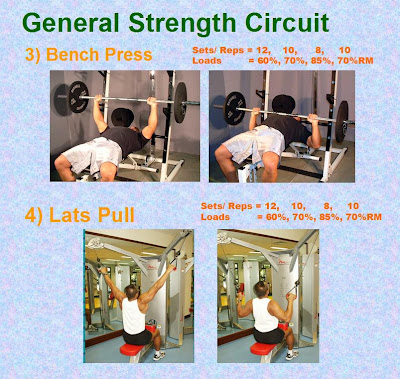Incorporating weight training into one's overall fitness program can provide many benefits to a runner training for events ranging from the sprints to the marathon. In this section, the benefits of total body conditioning through a weight-training program will be highlighted.
.
Benefits of a Weight Training Program
- Upper Body - A strong upper body helps minimizes fatigue and stiffness in the arms, shoulders, and neck areas that in turn, enables a runner to maintain form late in a marathon or long run. Legs move only as fast as the arms swing. The runner with a strong upper body will find more power for the sprint to the finish line, an easier crank up a hill, and better balance when running on trails. In short, all of these add up to an ability to run faster and more efficiently.
.
- Legs - Running creates a slight muscular imbalance in the legs as the hamstrings and calf muscles develop at a faster rate than the quadriceps and shins. Weight training helps address this imbalance. Additionally, strong quads and hips help protect these areas from a variety of injuries. Strong legs also offer protection from the possibility of injury when running at a fast pace downhill.
- Abdominals - A strong abdominal region helps protect the back while at the same time, assists in maintaining proper running form and posture.
Related Benefits of Total Body Conditioning Through Strength Training
- Fat Burning - The increase in lean muscle mass that results from strength training is the key to your body's ability to metabolize glucose and thus burn fat. This occurs because muscle cells require more energy (and also burn more calories) than fat cells.
- Body Composition Changes - As one ages, the body changes in composition as lean muscle decreases while fat deposits increase. Muscular strength also declines approximately 5% per decade for the untrained individual. Strength training slows down this process even as one reaches their senior years.
.
- Bone Protection - Weight training helps protect bones. This is an important benefit, particularly for women, as decreased estrogen production causes bone demineralization. This in turn increases the risks of osteoporosis and the additional risk of incurring stress fractures. Muscles tugging on bone structure as a result of weight training facilitate bone regeneration.
.
- Diabetes and Heart Disease - According to the literature, weight training seems to reduce the risk factors for adult-onset diabetes as well as heart disease.
Final Thoughts
It is important to keep in mind that you probably won't lose weight when you infuse a weight-conditioning program into your overall fitness routine. Assuming that you eat sensibly, your percentage of total body fat (the true measure of progress) should decrease. Thus, weighing yourself on scales can be very misleading and perhaps may also be discouraging.Many people who first begin a weight-training program express concern that they will develop huge, bulky muscles. Unlike power lifters and body builders who focus their workouts on lifting the heaviest amount of weight they can handle for a few repetitions, the notion of "bulking-up" is not grounded in reality. By following the recommendations outlined in this section, you will instead become a stronger runner with improved muscular tone and definition.

















For your leisure reading ^__^
Enjoy!









































